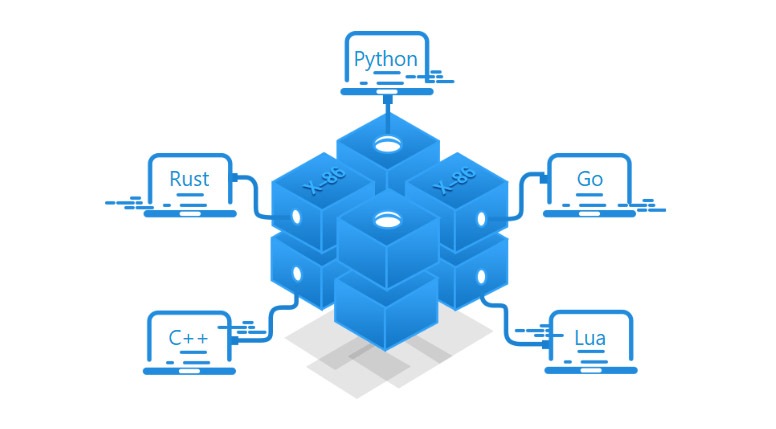As blockchain technology becomes increasingly popular it is also becoming more important for individuals and companies to embrace the technology.
That has created a market for platforms that are meant to enhance the uses of blockchain technologies. One of the leaders in that space is Qtum, a platform that makes the blockchain more accessible for companies who want to build and deploy decentralized applications (dApps).
After creating dApps with Qtum they can be deployed on mobile devices, and are compatible with all the major blockchain ecosystems, which hasn’t been possible up until now. In essence, Qtum is a toolkit for developers to create dApps that are useful for real-world business oriented purposes.
Qtum is unique in that it uses a modification of the Bitcoin Core alongside an inter-compatible version of Ethereum’s Virtual Machine. The combination of the two gives the reliability that blockchaona are known for, along with the limitless opportunities presented by smart contracts.
Qtum Review: The Team
The Qtum team has come to the project from a variety of sources, including the Ethereum and Bitcoin communities, but also including traditional businesses such as Nasdaq, Tencent, Alibaba and Baidu. This gives the team blockchain, fintech and venture capital experience, as well as executive level management experience with some of China’s largest technology companies.
Patrick Dai has extensive blockchain experience and worked with Alibaba. Neil Mahi has 20 years of experience working with software development plus four years with the blockchain. Jordan Earls is part of the cryptocurrency community and has done software development for years. Yunqi “Caspal” Ouyang is a web developer, Baiqiang Dong studied theoretical mechanics, and Xiaolong “Stephen” Xu has software development experience. The list goes on to include another dozen team members with similar experience.
Innovation is at the core of blockchain technology and this has helped put the technology, and the projects that are using it in manner useful to business, in the limelight. Bitcoin started the revolution, but its model is being upgraded and improved upon, and other projects are creating completely new and unique takes on decentralized consensus.
As the blockchain industry continues to expand there are an increasing number of companies who look to capitalize on blockchain technology. Unfortunately, many of the existing blockchain solutions have already shown their weaknesses and limitations. One glaring example of this is Ethereum, which is the most popular decentralized application solution. While the smart contracts delivered by Ethereum are a great step forward, the platform has shown how unsuitable it is when it comes to large network loads and scalability.
It was just such issues that led to the creation of the Singapore-based Qtum Foundation and the development of the QTUM blockchain.
This unique blockchain solution uses the stability of the Bitcoin Core together with an application development environment that provides capabilities similar to Ethereum. The end-goal is to provide businesses with an improved smart contract platform that has a secure, stable and transparent environment as well as extended functionality.
Qtum Explained
Qtum at its most basic is a blockchain and cryptocurrency meant to simplify the use of smart contracts by businesses. Much more than a basic blockchain and coin however, the foundation created a unique blend of Bitcoin and Ethereum that takes advantage of the strengths of each.
Qtum was created as a fork of Bitcoin Core, but by using several key tools the foundation created a hybrid blockchain that incorporates Ethereum’s Virtual Machine and smart contracts. The Bitcoin blockchain was used as the core because it is both stable and simple to build upon.
With the basic foundation in place Qtum then adds an abstraction layer that combines several virtual machines to add various functionalities. Of course the Ethereum VM is the most important since it gives Qtum the ability to use smart contracts.
When you get down to a more granular level, each layer comes with its own specific purpose. Bitcoin was put in as a foundation because it gives the blockchain the ability to use the Unspent Transaction Outputs (UTXO) model. This is a simplified account model that avoids the traditional banking account model in favor of a more peer-to-peer oriented account model.
Rather than having individual accounts that are debit when there’s a transaction, this model writes all transactions as bank checks. With this model users need to specify not only the amount, but also who it is being credited to, and why it is being credited. This does help to simplify the creation of smart contracts. Each users’ balance is the sum of all the transactions they are capable of completing.
There’s one big problem with using the Bitcoin UTXO model, and that’s that Ethereum uses a traditional account model. With Ethereum each user carries a balance that can be debited to complete a transaction, with the destination account having the exact same sum credited. This has been one of the major issues in creating Bitcoin-Ethereum interoperability. Qtum has solved the problem by creating an Account Abstraction Layer that translates the Bitcoin UTXO output into an account style data that is readable by Ethereum.
This is important because the Ethereum aspect is the second major component of Qtum. Without Ethereum Qyum wouldn’t have the ability to create smart contracts or dApps. The combination of Bitcoin and Ethereum features allows Qtum to focus on solving business and institutional problems with a stable and modular blockchain.
Qtum Review: Proof of Stake
One additional change that Qtum has made to improve it as a blockchain is the use of Proof of Stake consensus rather than Proof of Work.
Proof of Work is what both Bitcoin and Ethereum use as their consensus mechanism. PoW is based around miners validating transactions and creating new blocks in exchange for a reward. It was a good method when usage of Bitcoin was low and block processing was fairly easy.
The problem with PoW consensus is that it becomes increasingly more difficult to solve each block, and this has several negative impacts. The first is that mining itself takes longer, which causes the entire network to slow down. Then it becomes necessary to have increasingly more powerful computers to solve blocks, as well as increasingly large amounts of electricity to power the computers.
Bitcoin mining farms use huge amounts of electricity, and this costs the miners fiat cash. This pressures cryptocurrency markets as miners may decide it isn’t worth it to mine any longer when prices get too low. And for business uses Proof of Work is considered inefficient. Businesses need transactions processed rapidly and reliably, not delayed by hours or even days. Such network delays cost businesses money.
Proof of Stake does away with costly and slow mining by randomizing the creation of each new block. The randomization is brought about by a deterministic algorithm that is based on user stake. Thus there is no need for miners, costly mining hardware, or large energy consumption. Every coin is created when the blockchain is created, which means the only reward is in holding the coins and collecting transaction fees. This not only lowers overhead costs, it also increases transaction speeds.
Businesses prefer this consensus mechanism over Proof of Work as it keeps transaction fees small and transaction speeds fast. Doing away with miners also avoids the possibility of a 51% attack occurring and it keeps crypocurrency prices higher since there’s no selling to cover fiat expenses.
Qtum Review: Use Cases
The Qtum Foundation is reaching out primarily to businesses, positioning themselves as a superior blockchain solution that avoids the complications and risks that are associated with Bitcoin and Ethereum, while maintaining the benefits. Others have tried to provide this same use case, but Qtum has done so more effectively, and has made itself a useful solution in a number of situations.
The foremost obvious use case is the Qtum hybrid smart contracts that are more secure than Ethereum smart contracts thanks to the use of Bitcoins UTXO. Ethereum has already been in the news several times for incidents that have caused millions of dollars in losses due to a failure in the smart contract technology. By adding the secure transactions offered by Bitcoin’s UTXO there is an added layer of protection in the Qtum smart contracts.
 One huge advantage for businesses is the ability of Qtum developers to created dApps quickly and easily in almost any computer language. There have already been several applications built on the Qtum chain. These include traditional uses such as healthcare records, as well as more unique uses such as artist copyright protections, prediction markets, and food traceability.
One huge advantage for businesses is the ability of Qtum developers to created dApps quickly and easily in almost any computer language. There have already been several applications built on the Qtum chain. These include traditional uses such as healthcare records, as well as more unique uses such as artist copyright protections, prediction markets, and food traceability.
The Qtum Foundation hopes to attract larger institutions and eventually become the bridge for B2B transactions. The secure use of the combination of UTXO and smart contracts makes Qtum a truly trustless ecosystem. This should make the platform very attractive to businesses as it removes the need for middlemen and reduces overhead costs for the businesses.
Qtum Real-World Penetration
Qtum has moved past its initial stages and is maturing, having already penned agreements with several important companies. This could give Qtum additional visibility and leverage its appeal as a hub for blockchain development in the coming months and years.
One major partnership struck by the Qtum Foundation is with Starbucks, although the terms of that agreement haven’t been fully released. They have also created a relationship with 360 Finance in China and will be partnering to create a blockchain research lab, which will be used to improve on the Qtum technology.
While 2018 has been a bad year across cryptocurrencies, there are still high hopes for Qtum to reach its full potential. It still needs to prove itself to the private sector, but this is true for blockchain in general. Once it gains acceptance and momentum it could become the primary dApp development platform, giving businesses a better, safer and easier way to create dApps.
QTUM Token
The QTUM token was launched in March 2017 and raised $15 million in five days, with the tokens being sold for $0.30 each. The token quickly rose and was soon around the $10 level, where it remained throughout 2017. The massive cryptocurrency rally at the close of 2017 and start of 2018 took QTUM to its all-time high of $103.45 on January 6, 2018. Since then the token has been trending steadily lower along with the rest of the crpytocurrency markets, and as of August 2018 is at $6.27.
There are many smaller exchanges offering QTUM for purchase with BTC, ETH and USDT. The largest volumes are being traded at ZB.com, followed by LBank. The token is available at Binance and Huobi, but volumes are quite low.
For storing Qtum there are several options. Qtum offers a web based wallet, and they’ve also released both desktop and mobile versions of their wallet. Qtum is also supported by Electrum on Desktop and by QBao and Bitpie on mobile. And for those who are really concerned with safety, the Ledger Nano S also supports Qtum storage.
The Future of Qtum
Qtum is striving to create industry standards for dApp development by fostering cooperation with partners and third-parties. Part of the future vision includes a smart contract hub that’s complete with a library of secure templates that have already been subjected to thorough testing. These smart contract templates will include options for customizations based on industry usage, such as telecommunications, Internet of Things, logistics, or social networks.
If the Qtum Foundation is successful it will create the public blockchain for business use. The first step for the team is to complete development of the platform, after which they will seek to engage with various industries, even those that aren’t traditionally associated with technology. Initially the team wants to focus on the counterfeit protection, mobile telecommunications, finance manufacturing and logistics industries.
Qtum is working diligently now, but always has an eye for future developments and improvements. This is why Qtum is already compatible with all the Ethereum contracts and existing Bitcoin gateways. The team plans on also including backwards compatibility, so that functionality won’t be impacted, even by future updates.
Qtum Review: Conclusion
Qtum’s goal is to make it easier and more straightforward for business and individuals to use blockchain technology to create decentralized applications. They’re tackling this by combining the most useful features of Bitcoin and Ethereum, and improving on both in the process. While it needs to start small, it can grow very quickly if it realizes its vision, as the platform it looks to build will be extremely useful for businesses, allowing them quicker dApp development and potentially significant cost cutting.


